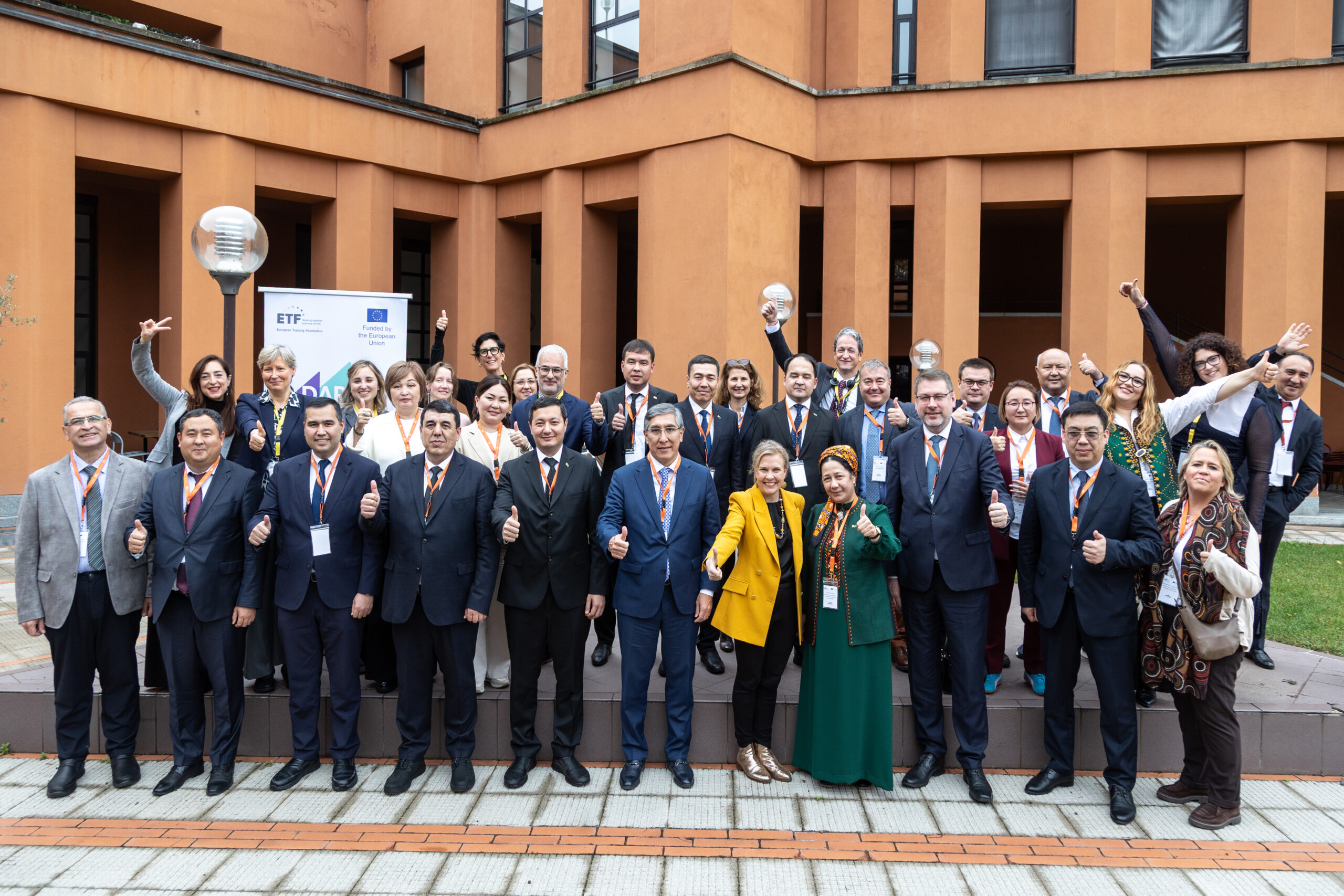TURIN – Government officials, experts, and policymakers from Central Asia and the European Union gathered on Oct. 30-31 in Turin for the fourth high-level meeting of the EU-funded 10 million euro DARYA program.
DARYA is the European Union’s first-ever regional project supporting young people in Central Asia through measures fostering inclusion and labour market skills. Photo credit: ETF
Hosted by the European Training Foundation, the meeting brought together deputy ministers of education and labor from Kazakhstan, the Kyrgyz Republic, Turkmenistan, and Uzbekistan, as well as representatives from EU institutions, international organizations, and partners. Launched in 2022, DARYA, which stands for Dialogue and Action for Resourceful Youth in Central Asia, is a five-year program aimed at supporting Central Asia in advancing employability and inclusive and sustainable skills development.
Opening the event, ETF Director Pilvi Torsti reflected on the decades of the ETF’s work in the region, describing it as a “strong and trusted partnership.”
“Our cooperation is built on dialogue, evidence, and also shared ambition. It is connected to our shared commitment to young people and the skills and competencies they really need today and for their future. And that is the flagship of that partnership. It represents what we can achieve together when dialogue is structured, aspirations are really met, and the cooperation is continuous, so then the ideas can turn into results,” said Torsti.
Pilvi Torsti. Photo credit: ETF
As the program is halfway through, Torsti said it has delivered progress, reflected in stronger policy coordination and growing links between education systems and the labor market. But she stressed that the work is just beginning.
“This policy dialogue is not an end in itself. It is a process that should help countries to move to design and then from design to implementation,” she added.
Torsti pointed to progress since last year’s meeting in Tashkent, saying countries are now “putting structure to those commitments,” including through developing a skills roadmap and new partnerships that aim to turn ideas into measurable outcomes.
The skills partnership model, she noted, links policy to investment, education to employment, national reforms to regional cooperation, and competencies to competitiveness.
“Here at the ETF, we always say there is no competitiveness without competencies,” she added, highlighting how global pressures require countries to work together.
Moving forward, Torsti stressed three priorities. They include a regional skills roadmap aligned with national priorities, turning dialogue into action through joint projects and targeted investments, including via the EU Global Gateway, and embedding initiatives locally to ensure sustainability and lasting impact.
Perspective from Kazakhstan
Kazakhstan sees skills development and strong cooperation between government, business, and educational institutions as central to its long-term competitiveness, said Kazakh Vice Minister of Labor and Social Protection of the Population Askar Biakhmetov. He reiterated that human capital development is a strategic priority.
“In this context, cooperation with the European Union plays an important role by enabling the modernization of workforce training, the implementation of independent qualification assessment, and the updating of professional standards. We are consistently applying a modular and competency-based approach to respond more quickly to the labor market demand and enhance the quality of specialist training,” said the Kazakh official.
According to Biakhmetov, employment and human capital development are designated national priorities under Kazakhstan’s Social Code. Career centers operate across the country, and the electronic labor exchange fully automates job matching and subsidies for workplace support.
Active labor measures include subsidized jobs, entrepreneurship support and short-term vocational training. Programs also target young people entering the workforce, including first-job initiatives and mentorship programs connecting young specialists with retirees.
“An important measure is the support of self-employment and entrepreneurship. Through the Bastau Business project, citizens receive training in the basics of entrepreneurship and can then obtain grants to start or expand their own businesses. This contributes to the creation of new sewing workshops, bakeries, beauty salons, dairy production and other types of small enterprises,” he explained.
In 2023, the government also adopted a labor market development concept through 2029 aimed at creating quality jobs, raising productivity and promoting productive employment.
Biakhmetov stressed the instrumental role of the DARYA project in the country’s efforts.
“This model has made it possible to establish new processes, from forecasting labor market needs to developing flexible qualifications and introducing modern pedagogical practices,” he added.
Alma Kazhkenova, head of the Department for Teacher Professional Development, TVET System Internationalization, and Monitoring at the Ministry of Education, also stressed the program’s crucial role. She emphasized that the program supports labor market development, dual education, teacher training, and the internationalization of technical and vocational education, areas critical for Kazakhstan and the wider Central Asian region.
Kazhkenova noted that Kazakhstan has placed strong emphasis on vocational training, recalling President Kassym-Jomart Tokayev’s decision to designate 2025 as the Year of Working Professions.
“Central Asia faces similar challenges in technical and vocational education. One of the key questions is preparing a workforce that meets labor-market needs, and we must keep pace with rapid change,” Kazhkenova said.
Kazakhstan’s major industrial projects and ongoing green transition efforts, she added, are creating additional demand for skilled specialists. Kazhkenova also mentioned the recent pledge by the EU institutions to invest in the Kambarata-1 hydropower project.
Strategic necessity
Addressing the meeting, EU Special Representative for Central Asia Eduards Stiprais explained why the DARYA project is meaningful to the EU and why the EU remains committed to supporting it.
“Firstly, the momentum for developing the relations between the European Union and the Central Asian countries has never been as significant as it is today. Our focus is on the economic development of the region, and a key part of this is attracting increased investments. However, to fully leverage these opportunities, we need a workforce that is both well-educated and highly skilled,” said Stiprais.
Eduards Stiprais. Photo credit: ETF
For Central Asia, where nearly half of the population is under 30, investing in skills development and training is a window of opportunity
“In this way, supporting human capital development is not just a social priority. It is a strategic necessity for attracting investment and fostering a competitive, resilient regional economy. The presence of well-trained professionals at all levels, from skilled workers to managers, makes the region a more attractive and secure destination for European investments,” he explained.
He noted that practical skills not only improve young people’s confidence and employability, but also reduce vulnerability in a fast-changing labor market. Strengthening vocational pathways, he noted, helps build a stronger, more cohesive society capable of withstanding future uncertainties.
The third factor is what Stiprais described as a “unique demographics” of the region.
“The young generation of Central Asia is the region’s greatest asset and its hope for the future. With a median age of just around 26 years and nearly one-third of the population under 15, Central Asia remains one of the youngest regions in the world. By 2050, the region’s population is projected to reach around 114 million, with almost two-thirds of its people still of working age,” said the EU official.
Reflecting on his experience working across Central Asia, Stiprais emphasized the region’s potential and the central role of education in unlocking it.
“Throughout my career, I have had the privilege to serve and travel extensively in this region, and I have seen firsthand the talent, determination, and opportunities that exist there. There is a vast potential across your countries, and I firmly believe that education is the key to unlocking it. Policies must align education with the needs of the labor market, creating flexible systems that respond to today’s global challenges. Political will is essential for short-term cooperation, but is not enough of its own. Initiative and functioning platforms are equally crucial,” he explained.
The Global Gateway, the EU’s flagship connectivity and investment strategy, underpins the DARYA project’s regional efforts. Originally set with an investment target of 300 billion euros for 2021-2027, the program has mobilized over 306 billion euros in just four years, reaching its goal ahead of schedule.
On the first day of the high-level meeting in Turin, delegates also stepped outside the conference halls. The day featured visits to Apro Formazione, a leading vocational training hub, and to Ferrero’s iconic plant in Alba, where one of Italy’s most global brands traces its roots, two examples of how Italian expertise connects hands-on learning with global-scale innovation.





